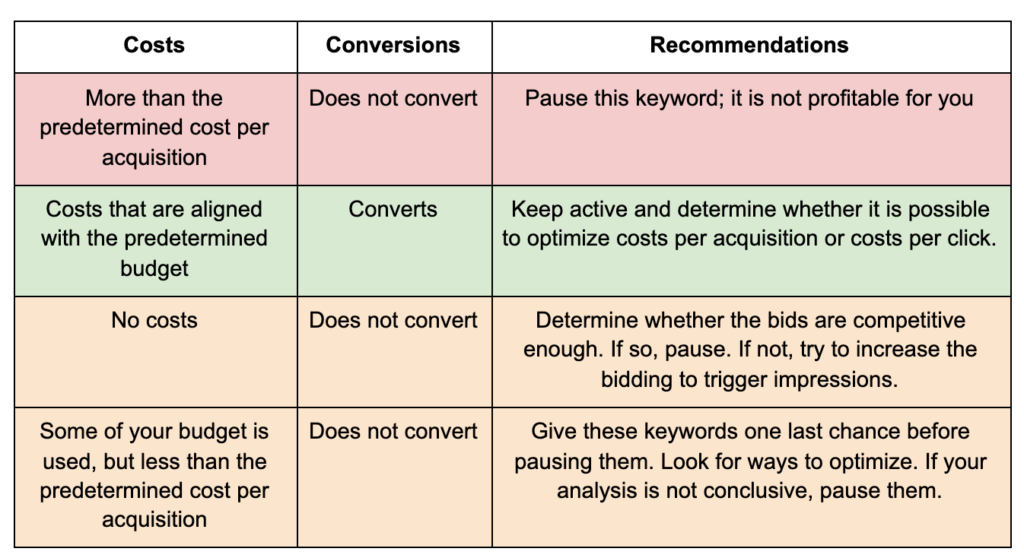How can you effectively optimize your keywords on Google Ads campaigns?
The article delves into the significance of enhancing Google Ads campaigns by concentrating on keywords and evaluating their effectiveness. It covers essential aspects such as determining campaign objectives (awareness or conversions), fine-tuning CPC for awareness and CPA for conversions, and ensuring adequate data for evaluation purposes. The importance of comprehending the types of keywords (brand, competitive, generic) and refining them based on various factors like cost, conversions, cost per acquisition, click-through rate, quality score, and Lost Impression Share Rank is highlighted.
Moreover, the article suggests that decisions should be data-driven rather than assumption-based, recommends analyzing data over an extended period for improved insights, and adjusting CPCs according to performance indicators. It also provides guidance on enhancing keywords with different quality scores and managing CPCs based on CTRs and CVRs.
In summary, the article serves as a comprehensive resource for optimizing keywords in Google Ads campaigns to enhance performance and achieve desired outcomes efficiently.
When it comes to optimizing your Google Ads campaigns, a large part of your time will be allocated to monitoring and improving the performance of your keywords. That said, it’s not an easy task and you may quickly become confused.
First of all, you need to know:
- Your main campaign goal. Oftentimes, your goal will be awareness or conversions.
- The goal will determine what metrics you will need to pay attention to.
- Awareness: Optimize your CPC
- Conversions: Optimize your CPA
Your maximum CPC that you are willing to bid on. - Your maximum CPA that allows you to be profitable.
Finally, make sure you always have enough data to base your analysis on. This means you need at least 300 to 500 impressions and 100 to 300 clicks per campaign.
Optimize your keywords according to their nature
Be aware of the nature of your keywords in order to optimize them.
Brand keywords:
You should, in theory, have the highest quality scores and the lowest CPCs on these types of keywords. You want to be visible as much as possible when it comes to your brand. Make sure you always have competitive CPCs to maintain your brand position.
Competitive keywords:
In theory, your quality scores will naturally be low and your CPCs will often be very high. However, it all depends on your goal: you will have to determine how high you want to bid to gain visibility over your competitors, because the amounts can quickly rise.
Generic keywords:
These are very often the ones that will need to be optimized since they are at the heart of the conversion funnel.
Optimize your keywords to keep only the best ones
What “works” in theory and practice can be two different things. Oftentimes, keywords that you choose may not perform as much as you would like.
Therefore, always base your optimizations on your data and not on your perceptions. One last piece of advice before getting started: it’s always better to work over long periods of time, such as the past 3 months. This will make decision-making easier and closer to the reality of your campaigns.
Filter by cost and conversions
First, look at the cost per keyword in relation to the conversions obtained.

Simply put, eliminate anything that doesn’t convert (but makes you spend). Keep what does convert. You will then need to check the cost per acquisition to determine if the keywords are profitable even when converting.
Filter by cost per acquisition
A keyword that converts is good, but not at any cost. After you initially filter your campaign, determine the keywords for which you want to lower the cost per acquisition.

Simply put, lower the CPCs of keywords that have a CPA that is too high. Keep or even increase the CPCs of keywords that have a profitable CPA.
Filter by click-through rate
The click-through rate (CTR) is very important as it enters into the equation of your quality score. Some people like to take a standard value (often 1 or 2%) and optimize according to this standard. That said, a CTR of 2% can be bad as well as very good, depending on your offer and industry. Instead, determine your average CTR in relation to your usual campaign performance.

In short, eliminate or work to improve keywords with lower-than-average CTRs.
Filter by quality score
Your quality score has a direct influence on your performance as it determines your CPCs, impressions and position in search results.

In short, eliminate keywords with a quality score below 3 and optimize those between 4 and 6.
Filter by Lost Impression Share Rank
Finally, the Lost Impression Share Rank indicates the competitiveness of our bid compared to the current market.

- Increase your CPCs only if your CTRs and CVRs are high and within the limit of your CPA.
- Increase your CPCs if your Lost Impression Share Rank high and within the limit of your CPA.
- Lower your CPCs if your CTRs and CVRs are not optimal.
- Lower your CPCs if your CPA is high.
- Pause keywords that spend your budget, but do not convert.
- Pause keywords that have a quality score below 3.
- Improve keywords that have quality scores between 4, 5 and 6.
For some help in the field or simply to hire a certified agency, contact us!

